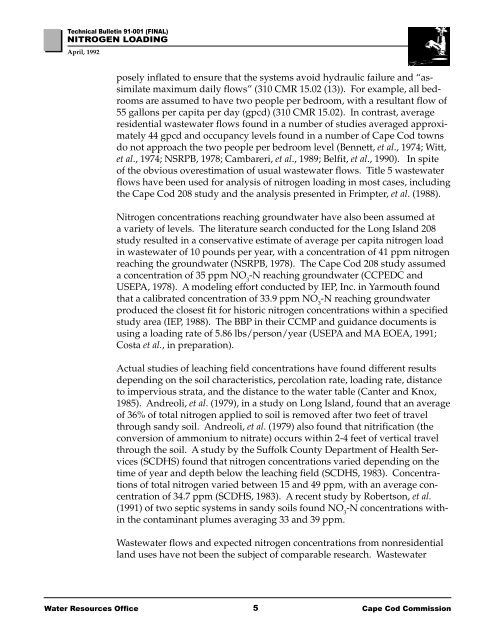Technical Bulletin 91-001 Nitrogen Loading - Cape Cod Commission
Technical Bulletin 91-001 Nitrogen Loading - Cape Cod Commission
Technical Bulletin 91-001 Nitrogen Loading - Cape Cod Commission
Create successful ePaper yourself
Turn your PDF publications into a flip-book with our unique Google optimized e-Paper software.
<strong>Technical</strong> <strong>Bulletin</strong> <strong>91</strong>-<strong>001</strong> (FINAL)<br />
NITROGEN LOADING<br />
April, 1992<br />
posely inflated to ensure that the systems avoid hydraulic failure and “assimilate<br />
maximum daily flows” (310 CMR 15.02 (13)). For example, all bedrooms<br />
are assumed to have two people per bedroom, with a resultant flow of<br />
55 gallons per capita per day (gpcd) (310 CMR 15.02). In contrast, average<br />
residential wastewater flows found in a number of studies averaged approximately<br />
44 gpcd and occupancy levels found in a number of <strong>Cape</strong> <strong>Cod</strong> towns<br />
do not approach the two people per bedroom level (Bennett, et al., 1974; Witt,<br />
et al., 1974; NSRPB, 1978; Cambareri, et al., 1989; Belfit, et al., 1990). In spite<br />
of the obvious overestimation of usual wastewater flows. Title 5 wastewater<br />
flows have been used for analysis of nitrogen loading in most cases, including<br />
the <strong>Cape</strong> <strong>Cod</strong> 208 study and the analysis presented in Frimpter, et al. (1988).<br />
<strong>Nitrogen</strong> concentrations reaching groundwater have also been assumed at<br />
a variety of levels. The literature search conducted for the Long Island 208<br />
study resulted in a conservative estimate of average per capita nitrogen load<br />
in wastewater of 10 pounds per year, with a concentration of 41 ppm nitrogen<br />
reaching the groundwater (NSRPB, 1978). The <strong>Cape</strong> <strong>Cod</strong> 208 study assumed<br />
a concentration of 35 ppm NO 3<br />
-N reaching groundwater (CCPEDC and<br />
USEPA, 1978). A modeling effort conducted by IEP, Inc. in Yarmouth found<br />
that a calibrated concentration of 33.9 ppm NO 3<br />
-N reaching groundwater<br />
produced the closest fit for historic nitrogen concentrations within a specified<br />
study area (IEP, 1988). The BBP in their CCMP and guidance documents is<br />
using a loading rate of 5.86 lbs/person/year (USEPA and MA EOEA, 19<strong>91</strong>;<br />
Costa et al., in preparation).<br />
Actual studies of leaching field concentrations have found different results<br />
depending on the soil characteristics, percolation rate, loading rate, distance<br />
to impervious strata, and the distance to the water table (Canter and Knox,<br />
1985). Andreoli, et al. (1979), in a study on Long Island, found that an average<br />
of 36% of total nitrogen applied to soil is removed after two feet of travel<br />
through sandy soil. Andreoli, et al. (1979) also found that nitrification (the<br />
conversion of ammonium to nitrate) occurs within 2-4 feet of vertical travel<br />
through the soil. A study by the Suffolk County Department of Health Services<br />
(SCDHS) found that nitrogen concentrations varied depending on the<br />
time of year and depth below the leaching field (SCDHS, 1983). Concentrations<br />
of total nitrogen varied between 15 and 49 ppm, with an average concentration<br />
of 34.7 ppm (SCDHS, 1983). A recent study by Robertson, et al.<br />
(19<strong>91</strong>) of two septic systems in sandy soils found NO 3<br />
-N concentrations within<br />
the contaminant plumes averaging 33 and 39 ppm.<br />
Wastewater flows and expected nitrogen concentrations from nonresidential<br />
land uses have not been the subject of comparable research. Wastewater<br />
Water Resources Office 5<br />
<strong>Cape</strong> <strong>Cod</strong> <strong>Commission</strong>
















